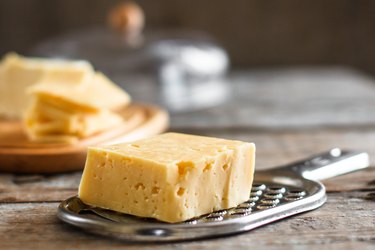
Named for a Medieval village in Switzerland, Gruyere is a hard yellow cheese that's easier to eat than to pronounce. Not to be confused with American-made "Swiss cheese" that's famously covered with holes, Gruyere has none. Due in part to its versatility served on a cheese platter or melted into a baked dish or runny fondue, Gruyere is among the classic varieties on Switzerland's long list of 450 different types of cheese. If you cannot find it, substitute for Gruyere with another suitable cheese.
What Is Genuine Swiss Gruyere?
Video of the Day
Dairy cows are fed on natural forage to provide the quality milk for production in giant copper vats crafted into 80-pound wheels using a method that's been in place for more than 900 years. This distinctive Gruyere cheese taste from the lush green alpine foothills of Switzerland's Fribourg canton is recognized by a Controlled Designation of Origin, or AOC.
Video of the Day
To create a traditional Swiss fondue, Gruyere is combined with two or more cheeses in a slowly simmering communal pot over a low flame. The most popular choices for cheese fondue are Vacherin, Raclette, Comte and Appenzeller, so if the budget requires or the need arises, there are plenty of Gruyere cheese alternatives.
How Much Is Gruyere?
The average price is generally $15 to $20 per pound for authentic, Swiss-made Gruyere that carries the authentic AOC label. Gruyere is aged for five months or possibly up to 24 months to develop a more intense flavor.
The even higher cost of aged Gruyere is reflected in its price tag, adjusted upward for the additional months of maturation. Less-expensive Gruyere from America may use pasteurized milk and be aged for only four months. Hence, it has a lower cost and a compromised flavor.
A Good Replacement for Gruyere Cheese
To replace Gruyere in a recipe, choose a soft, easy-to-melt cheese with a nutty, almost spicy flavor. Since American cheddar has an entirely different taste profile and melts too fast, try another European cheese as a replacement for Gruyere, one which may be easier to find in the grocery store or may carry a lower price tag.
The top cheese contenders for Gruyere substitution are Beaufort and Conte from France, considered quite similar. When grocery shopping in the cheese section or at a specialist deli, also look for Emmenthal (sometimes referred to as Emmenthaler) from Switzerland; this is the one with those signature holes.
Norwegian Jarlsberg, a pale-yellow cheese, is an excellent substitute for Gruyere, especially for melting cheese on top of grilled vegetables. Another very reasonable option is any Alpine Gruyere-style cheese that's made in the mountains of nearby Austria or France.
What About Substituting Parmesan for Gruyere?
Parmesan is the name for the domestic version of Italy's "king of cheese." On a cheese platter, imported Parmesan is tasty, but it doesn't make a good replacement for Gruyere.
In cooking, a crumbly Parmigiano Reggiano from Italy makes a good substitute for Gruyere when combined with Fontina to facilitate melting. Keep in mind that quality Parmigiano Reggiano is not a budget purchase. This Italian-import substitution for Gruyere is likely to be around $15 per pound, plus the Italian or Danish Fontina, which is typically about $14 per pound.
Can Gruyere Be Frozen?
There's good news for home cooks who prefer to keep Gruyere on hand rather than subbing another cheese. Gruyere can be grated and frozen indefinitely in a sealed plastic storage bag for later use in sauces, soups, gratins, casseroles, quiches and even souffles. Moms and dads take note: Gruyere is particularly tasty in macaroni and cheese for the kids.